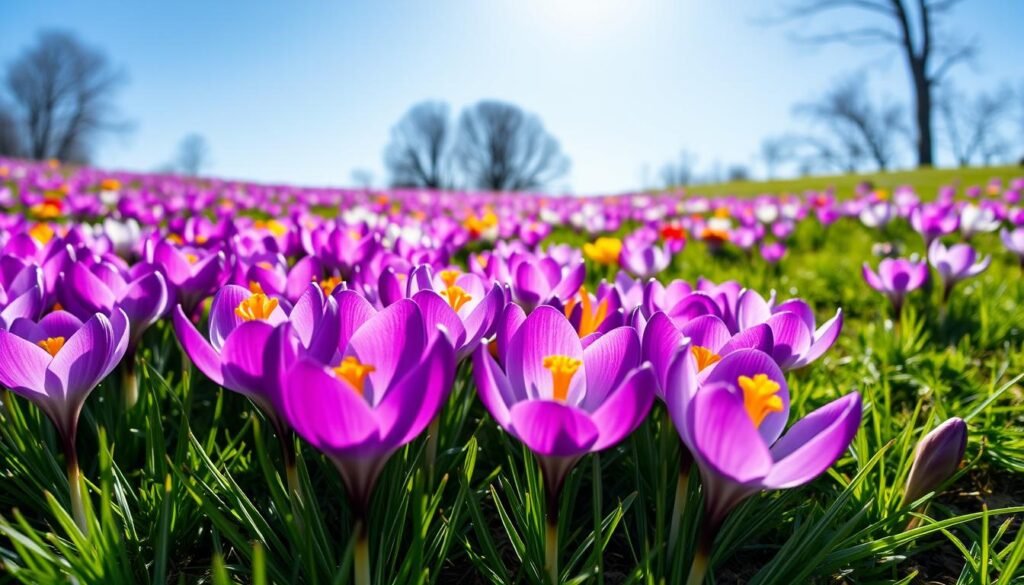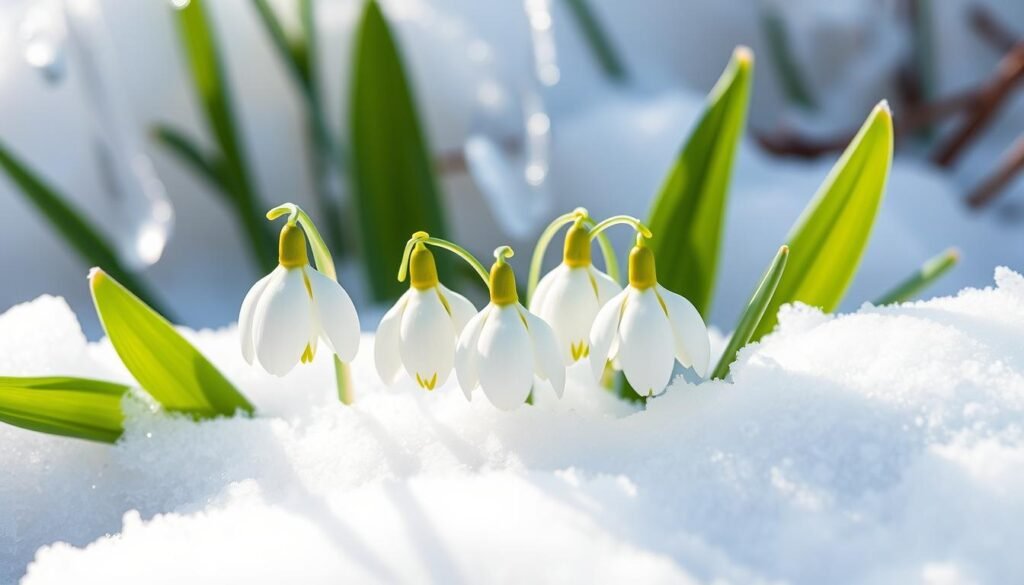Autumn gardening brings spring gardens to life. It’s key to plant spring-flowering bulbs before winter hits. Experts advise planting from October to December. These bulbs need cold to wake up and bloom in spring.
Tulips and Daffodils are great for many areas, growing in USDA Zones 3 to 9 and 3 to 7, respectively. Mixing different types guarantees flowers from early to late spring. Let’s look at the best bulbs to plant this fall.

1. Tulips: The Classic Choice for Spring Gardens
Tulips stand out as the iconic spring flower, brightening gardens with their colors. They have over 3,000 types, making them essential for spring gardening. If planted by late August, they add varied colors and shapes to your space.
For the best growth, plant tulip bulbs deeply, about 6-8 inches down. They should be 4-6 inches apart for enough room. They love the sun and dry soil, doing best in zones 3 to 8. Plant them in clusters for a beautiful display, with big ones in fives and small ones in 25s or more.

Post-bloom care is crucial for tulips. Let their leaves wilt naturally by late June for energy storage. Cut tulips stay fresh in a vase for about a week, continuing to grow.
Deep planting helps avoid vole damage, a common tulip issue. Despite small problems, tulips give a stunning spring show. They are a top choice for anyone wanting a beautiful garden in spring.
2. Daffodils: Reliable Spring Bloomers
Daffodils, also known as Narcissus flowers, are great for any spring garden. Their colors include creams, yellows, peaches, and oranges. These flowers can grow from 6 to 30 inches tall. They do best in full or partial sun and need soil that drains well.
There are many types of daffodils, each with different needs. For example, “Marieke” Daffodils grow well in Zones 3-8. The “Abba” Daffodil prefers Zones 5-9. “Orange Comet” and “Snow Baby” are good for Zones 4-9. “Carlton” Daffodil suits Zones 4-8, and “Barrett Browning” is great for Zones 3-8. The “Avalanche” variety, or “Seventeen Sisters,” has 15-20 white flowers on each stem.

When planting daffodils, space them 6 to 12 inches apart. This spacing helps them grow well. Plant them about 6 inches under the soil. In lighter soils, go as deep as 8 inches. Choose large and healthy bulbs to plant before mid-October for a strong root system.
Every five to 10 years, you might need to divide daffodil bulbs. This is if they start flowering less or the flowers get smaller. To make sure your daffodils get enough food, add 2 to 3 pounds of garden fertilizer per 100 square feet. Use a mix like 6-24-24 before planting for the best results in spring.
3. Alliums: Eye-Catching Globes
If you want to add drama to your garden, consider allium spheres. These ornamental onions show off beautiful, round flowers. They come in colors like purple, white, and light-purple. The ‘Globemaster’ is a perfect example. These globes can be tiny at one inch or huge at 12 inches across. They make any pollinator-friendly garden look amazing.

Alliums are stunning and help the ecosystem thrive. They bloom from mid-spring to mid-summer. This offers nectar for bees and butterflies. For gardens that help pollinators, alliums are perfect. They grow well in zones 3 to 10. Most types do best in zones 3 to 9. They vary in size too. Some are five inches tall, and others reach four feet.
Planting these bulbs is easy. They need full sun but do ok in partial shade too. Choose a sunny place with soil that drains well. Bulbs should be planted with the pointy end up. The depth should be twice the bulb’s height. Plant them six to eight inches apart. Their size varies, but their blooms unite the garden. They bring unity, prosperity, patience, and luck.
“Allium bulbs are best planted in the fall for late spring and early summer blooms, providing an extended season of visual interest and ecological benefit,” according to the gardening experts at Eden Brothers.
4. Hyacinths: Fragrant Spring Delights
Hyacinths are top fragrant flowers for spring, perfect for any garden. They are known for their strong scent. These flowers bloom from early to mid-spring in colors like white, pink, and blue. Hyacinths add beauty to formal gardens, cozy cottages, or window boxes.

They grow best in U.S. zones 4 to 9, loving both full sun and partial shade. These bulbs reach up to a foot in height. Plant them in fall, before the frost, for a vibrant spring. They’re great at the front of gardens or in pots, filling the air with fragrance.
Hyacinths can also grow indoors with a chilling period of 8 to 12 weeks. This is perfect for those who love gardening inside. Once planted outside, they can bloom for up to four years. Yet, they might need new planting to keep them blooming well.
The scent of hyacinths is impressive, better than many other spring flowers. While grape hyacinths smell like fruit, and daffodils have a light scent, hyacinths are strong and lasting. Adding these flowers to your garden will make spring unforgettable.
5. Crocus: The Early Risers
Crocuses bloom early in spring, being the first to show up in our gardens. They peek out even before the snow is fully gone. The Crocus sativus stands out for its bright colors and ability to adjust.

These plants do best in zones 3 to 8, where they get enough sunlight. They need good soil to grow well and can get up to six inches tall. You have many choices, like the affordable Crocus etruscus Zwanenburg, which is a great deal. Another option is the beautiful Jeanne d’Arc Giant Crocus.
If you want a big splash of color, the Mixed Crocus Jumbo Pack is perfect. It gives you 100 bulbs for a good price. This pack fills your garden with many colors. These include purple, white, and even saffron hues, adding beauty and a bit of spice.
The snow crocus lights up gardens in late winter or early spring. Then comes the Dutch crocus with its bigger blooms. Crocuses bring bright, colorful flowers to your garden, signaling spring’s start.
6. Snowdrops: Delicate Beauty
Snowdrops, also known as Galanthus nivalis, bloom early in spring. They come from places like eastern Turkey and western Iran. These plants are great for cooler climates as they are hardy to zone 3. There are around 19 species of snowdrops, found in southern Europe and Asia Minor’s mountains.

Plant snowdrop bulbs in the early fall. They start rooting in a week or two. By late winter or early spring, their white flowers appear. Plant them 2 to 3 inches apart in soil that drains well. They like both sun and partial shade, especially under leafy shrubs. Snowdrops can resist deer and do not appeal to rabbits or rodents.
Snowdrops help attract bees to your garden. They are seen as bee-friendly and provide early nectar. This is great when other flowers haven’t bloomed yet.
Though it may take time for snowdrops to spread, they eventually form dense groups. Some can tolerate only zones 4 or 5, like the giant snowdrop (G. elwesii). Yet, with the right care, they can grow strong and last a long time.
If you’re looking to grow snowdrops, consider using raised garden beds. Raised beds improve soil, drainage, and protect against pests. They help create a flourishing garden.
7. Muscari: Grape Hyacinths for Vibrant Clusters

Muscari, also known as grape hyacinth, are beloved for their small, grape-like flowers. They stand out with their rich blue, purple, or sometimes white blooms early in spring. They’re tough, thriving in USDA zones 4 to 8, and they keep deer away.
Muscari adapt well in gardens. They love full or partial sunlight and do best in moist, well-draining soil. To plant them, wait for a cool spell in fall. Make sure the soil is not frozen. Put 10 bulbs per square foot into the soil, three inches deep, with the pointed end up.
Grape hyacinths spread fast. This makes them great for creating colorful carpets in your yard. But, they might spread too much if not kept in check. Still, their beauty adds a lot to spring gardens. After they flower, their leaves keep making food. This helps them bloom even more the next year.
To keep them healthy, water them so they get an inch of water a week. Remove spent flowers to help them grow better. You can pair them with crocus, tulips, and daffodils. This adds beautiful color layers to your garden.
Planting them in groups of ten or more gives a lush look. Or, grow them in pots for an early indoor show. Muscari are easy to care for. They offer bright colors and require little work. This makes them a top choice for a stunning spring display.
8. Irises: Bold and Beautiful Blooms
Iris reticulata blooms add a bright touch to gardens in late winter and early spring. They come in yellow, bronze, and purple, attracting bees and butterflies. These flowers do well in zones 3 to 9.
The Van Engelen Inc. flower bulb business, located in Bantam, Connecticut, offers beautiful Dutch iris bulbs. Varieties include ‘Silvery Sky,’ ‘Picasso,’ ‘Eye of the Tiger,’ ‘Pink Panther,’ and ‘Red Ember.’
For early spring blooms, plant these bulbs in autumn. They grow well with tulips and daffodils. Ensure they get enough sunlight and are in well-draining soil.
When planting, make sure the pointed end of the bulb is up. This helps avoid delayed flowering. Experts often use dibbers for planting. With yearly care like fertilization and mulching in cold areas, you can enjoy stunning irises.

9. Foxtail Lilies: Late Spring Showstoppers
Foxtail Lilies, or Eremurus robustus, make any spring garden stand out. They come from the dry lands of Afghanistan and Iran and do well in USDA zones 5 to 8. These plants need plenty of sun and good, well-draining soil. This makes them great for those who want beauty without too much work.
What’s really impressive about these lilies is how tall they can get. Some can grow to be nine feet tall. They have big, showy spikes of flowers that catch everyone’s eye. For the best show, plant them a foot apart and bury them under 2-3 inches of soil.
But it’s not just about looks with foxtail lilies. They draw in bees, butterflies, and hummingbirds. This helps your whole garden. It might take them 2 or 3 years to bloom from seeds, but they’re worth the wait. Check out this comprehensive guide for growing tips.
Caring for foxtail lilies is pretty straightforward. They don’t mind droughts, deer won’t bother them, and they can handle the cold. Some types are even okay in zone 4. Just make sure they have support so they don’t fall over. With a little care, your garden will have a stunning feature each spring.
10. Fritillaria: Early Spring’s Elegant Charmers
Fritillaria, a striking and unique spring-flowering bulb, is a fantastic addition to any garden for its dramatic, bell-shaped blooms and diverse range of species.

Known for their bold colors and intricate patterns, Fritillarias come in shades of purple, yellow, orange, and even checkerboard designs, adding a touch of exotic elegance to your garden. They are also deer-resistant, making them ideal for gardens where wildlife may pose a challenge.
Planting Fritillaria bulbs in autumn is essential for them to establish strong roots before the winter sets in, ensuring they bloom beautifully in spring. These bulbs thrive in well-draining soil and full to partial sunlight. They are perfect for adding vertical interest in borders, alongside other spring bloomers like tulips and daffodils.
Autumn planting gives them the necessary cool period they need to bloom profusely come spring. With their distinctive look and resilience, Fritillarias are a wonderful choice for gardeners seeking something out of the ordinary.
Spring-Flowering Bulbs: Essential Tips for Planting in Autumn
Planting bulbs in autumn is key for a colorful spring garden. This autumn bulb planting guide will help maximize your fall gardening work. It covers important bulb care requirements.
Start by choosing your bulbs. Big bulbs like tulips and daffodils are pricier but bloom more. They need to be planted 6-8 inches deep. Smaller bulbs, such as crocus, go 3-4 inches deep.
In Iowa, fall is great for planting spring-flowering bulbs, especially in October.
Pick a spot that gets six hours of sun daily. Bulbs do best in 50-55 degrees Fahrenheit. It’s important to plant by mid-October. This gives the bulbs time to root before it gets too cold.

Preparing the soil right is crucial. Ensure good drainage by adding organic matter. If your garden is wet, choose bulbs like camassias. Use bone meal fertilizer to encourage strong growth.
To see flowers all spring, plant different bulbs together. Space large bulbs 4-6 inches apart and small ones 2-3 inches. Water them right after you plant for the best root growth.
Early bloomers do well under trees since they flower before the leaves come out. Make sure to water new bulbs well. Follow these steps, and your garden will be stunning in spring.







